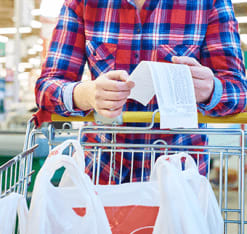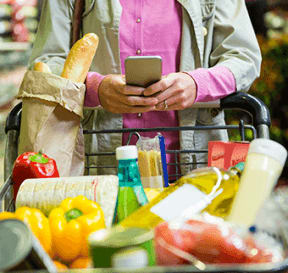Here’s what you’re probably thinking: How can I possibly customize the shopping experience for each and every one of my shoppers? Is that even a reasonable ask? Think about the square footage, SKU count, manpower, and marketing I need to manage day to day … I can’t adjust that for each shopper who visits my store.
You’re right … sort of … let me explain.
First let’s establish what it means to personalize the shopping experience. You have thousands of SKUs available in your store. You have upwards of 100 products on sale on any given day. You’ve got private label products, healthy choices, hot and cold deli, maybe even sushi and more.
That’s awesome. You cater to all, regardless of their preferences. You’ve spent a lot of time curating an assortment that can accommodate an entire community. No easy task, and you’ve done it well.
Now let’s talk about Sam. Sam shops in your store once a week. She spends about $65 a visit. She works during the day and grabs the groceries for her family of 4 on her way home after a long day of work every Tuesday. She tries to keep her family healthy and she is price conscious. She hasn’t really gotten into the whole online ordering and click to collect thing yet, although it’s likely she’ll try it some time soon. Time is tight, she just wants to get home, kick off those shoes, and spend a little quality time with her family.
You might recognize Sam by face, but do you actually know her? Do you know what brands she’s buying, who she’s buying for, and what’s important to her and her family?
If you don’t, you should, and you can, and it’s easy.
By the way, she expects you to, Amazon has trained her to expect that, as have others who are forward thinking and technologically advanced, think Kroger and others.

Step 1: Get to know Sam
By collecting SKU level data in real time and attaching that transaction to Sam you can build up her profile and begin to truly understand who she is, what she buys, when she buys, and what she expects. Don’t worry, she’ll opt-in for this, she gets it, and she wants the perks and personalization!
Step 2: Reward her for being loyal
Be sure to reward her for every time she comes back. It doesn’t have to be much. Most rewards based programs give back 1-2%. We realize that’s a lot in the world of grocery with your razor sharp margins, but it’s a marketing expense with direct, trackable ROI tied to it. It’s also a relatively small price to pay for a shot to earn her loyalty. And let’s be honest, there are a few other marketing initiatives you could cut back on a bit (ahem … paper based circulars … ahem).
Sorry I couldn’t resist. We can hash that one out another day.
Step 3: Adjust your marketing for Sam
As we build out Sam’s profile we’ll gather her birthday, mobile number, email address, and more. We’ve also got a really good understanding of what brands she has an affinity for and what she’s putting in her basket each week, all of that stuff we collected in step 1.
I can now do simple things like thank her for joining the program, wish her a happy birthday, have her buy 9 items to get 1 free at the deli counter, and reward her as a top shopper.
I can also do some more sophisticated things like tempt her to switch to my higher margin private label items, present her with more healthy choice items, and even reorganize some of my digital ads so that the products that are more relevant to her rise to the top.
The best part is, I can send it to her preferred touch point. I can text her (if I send you a text right now I guarantee you’ll read it). I can email her. If she’s downloaded the app, then I can send her a push notification. Pretty basic, yet sophisticated stuff.
Ever wondered what Sam was thinking after her last visit?
Now you can get that real time feedback too by simply tying a digital survey to her digital receipt. Boom! I now know exactly what she thought of her last visit. And her feedback as a top shopper is extremely valuable.

Step 4: It’s all about timing with Sam
Did you know that Sam has bought toilet paper from you once a month for the last year? Did you realize that she didn’t buy it last month? You should have. You can. In fact, you should send her a text message the day after with a note not to forget her toilet paper on her next visit or offering her a small discount to come get it this week. Why? Because guess where she bought it instead? Yup, it probably starts with Ama- and ends with -zon.
Did you know that Sam shops every Tuesday between 5-6pm, consistently, for the past year. Did you realize she hadn’t been in the store the last two Tuesdays? You should have. You can. In fact, as soon as her pattern is broken, you should send her a text message with a warm “We miss you” message and/or offer. You get the gist.
These are things that can be both data-driven and automated. Set it and forget it. Let the machines and technology do the simple work for you so that you can do what you do best inside your four walls.
We get it. You’ve got a tough job. You’ve got lots to manage. You want to, and probably already recognize that you have to cater to each and every shopper, but that’s a daunting task. We’re here to help. We have the tools and expertise and they’re both affordable and really user friendly. We’ve also got the support team to walk you through it from dedicated Customer Success Managers, to Data Scientists (yes that’s a real job – they’re off the charts smart people – and usually “not from around here!”), and even Graphic Designers.
It’s time to take personalization seriously. Your shopper both deserves and expects it. If you aren’t catering to your shopper, I guarantee someone else nearby (or a click away) is. You know it, and I know it … and Sam definitely knows it.
Let’s chat about it. Let’s get personal.
Enter your email address to follow this blog and receive notifications of new posts by email.